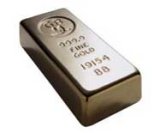 Discovery Information Discovery Information
|
| Who: Known to the ancients. Gold has been known and highly valued since prehistoric times. It may have been the first metal used
by humans and was valued for ornamentation and rituals. Eqyptian hieroglyphs from as early as 2600BC mention gold. The south-east
corner of the Black Sea was famed for its gold. Exploitation is said to date from the time of Midas, and this gold was important
in the establishment of what is probably the world's earliest coinage in Lydia between 643 and 630 BC.
|
|
 Name Origin Name Origin
|
| Gold from old English word geolo (yellow); Au from Latin: aurum (gold). |
| "Gold" in different languages. |
|
 Sources Sources
|
| Found in veins in the crust, with copper ore and natively. Major producers include South Africa, Canada, the United States and Western Australia.
|
| Around 1400 tons are produced each year. |
|
 Abundance Abundance
|
| Universe: 0.0006 ppm (by weight) |
| Sun: 0.001 ppm (by weight) |
| Carbonaceous meteorite: 0.17 ppm |
| Earth's Crust: 0.011 ppm |
| Seawater: 5 x 10-5 ppm
|
| Human: |
| 100 ppb by weight |
| 3 ppb by atoms |
|
 Uses Uses
|
| Pure gold is too soft for ordinary use and is hardened by alloying with silver, copper, and other metals. These alloys are mostly used in jewellery and coinage.
|
| White gold (an alloy of gold with platinum, palladium, nickel, and/or zinc) serves as a substitute for solid platinum.
|
| Gold is used in restorative dentistry especially in tooth restorations such as crowns and permanent bridges as its slight
maliablity makes a superior molar mating surface to other teeth, unlike a harder ceramic crown.
|
|
 History History
|
| Gold has been known and highly valued since prehistoric times. It may have been the first metal used by humans and was valued
for ornamentation and rituals. Egyptian hieroglyphs from as early as 2600 BC describe gold, which king Tushratta of the Mitanni claimed was "more plentiful than
dirt" in Egypt. Egypt and Nubia had the resources to make them major gold-producing areas for much of history. Gold is also mentioned several times
in the Old Testament, and is included with the gifts of the magi in the first chapters of Matthew New Testament The south-east
corner of the Black Sea was famed for its gold. Exploitation is said to date from the time of Midas, and this gold was important
in the establishment of what is probably the world's earliest coinage in Lydia between 643 and 630 BC.
|
| The European exploration of the Americas was fueled in no small part by reports of the gold ornaments displayed in great profusion
by Native American peoples, especially in Central America, Peru, and Colombia.
|
| Although the price of some platinum group metals can be much higher, gold has long been considered the most desirable of precious
metals, and its value has been used as the standard for many currencies (known as the gold standard) in history. Gold has
been used as a symbol for purity, value, royalty, and particularly roles that combine these properties. Gold as a sign of
wealth and prestige was made fun of by Thomas More in his treatise Utopia. On that imaginary island, gold is so abundant that
it is used to make chains for slaves, tableware and lavatory-seats. When ambassadors from other countries arrive, dressed
in ostentatious gold jewels and badges, the Utopians mistake them for menial servants, paying homage instead to the most modestly-dressed
of their party.
|
| During the 19th century, gold rushes occurred whenever large gold deposits were discovered. The first major gold strike in
the United States occurred in a small north Georgia town called Dahlonega. Further gold rushes occurred in California, Colorado, Otago, Australia, Witwatersrand, Black Hills, and Klondike.
|
| Because of its historically high value, much of the gold mined throughout history is still in circulation in one form or another. |
|
 Notes Notes
|
| On the 13th of March 2008 the price of gold reached $1000 per troy ounce (31.1035g) for the first time in history. This works
out at $32150 per kilogram!
|
| It is the most malleable and ductile metal known; a single gram can be beaten into a sheet of one square meter, or an ounce
into 300 square feet.
|
| Supposedly around half of the world's supply of gold is stored in the United States Treasury Department's gold depository
in Fort Knox Kentucky, which is considered to be one of the most secure buildings in the world.
|
| Because gold is traded like currencies, it has it's own ISO currency code, XAU (USD = US dollars, GBP = GB Pounds sterling
etc.).
|
| Gold in antiquity was relatively easy to obtain geologically; however, 75% of all gold ever produced has been extracted since
1910. It has been estimated that all the gold in the world that has ever been refined would form a single cube 20 m (66 ft)
on a side (8000 m3).
|
| At the end of 2001, it was estimated that all the gold ever mined totalled only 145,000 tonnes. |
|





 Discovery Information
Discovery Information
 Name Origin
Name Origin
 Sources
Sources
 Abundance
Abundance
 Uses
Uses
 History
History
 Notes
Notes
 Images
Images

